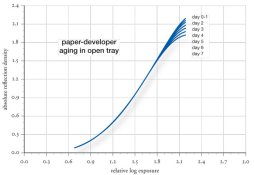Nor, I suspect, for LPD.
I really couldn't tell any difference between the prints I made in October with freshly mixed LPD and the ones I printed in January with the saved working solution, just poured into a plastic darkroom bottle, the air squeezed out and capped off. I expected the blacks to be inadequate and to mix fresh, but the prints looked fine.
I still have that bottle, but plan on mixing up fresh. I will be printing this weekend. I will make a print or two with the old stuff, then mix fresh and compare.
Results are in.
I made the best 8x10 I could of a negative I was working on, using the old bottle of developer mixed in September.
Then I mixed up a fresh half gallon (because I plan to make some 16x20s) and tried printing it and developing in freshly mixed working strength LPD.
First, the old developer had lost some activity as I needed less exposure with the fresh stuff. My exposure with the old developer was 20 seconds at f/11. With the fresh stuff I was printing at 15 seconds, same f-stop, with very similar results.
Similar, but not identical. The fresh developer is very slightly more contrasty, perhaps 1/4 of a paper grade, maybe a bit more than 1/4 grade but definitely less than 1/2 grade. I can't tell any difference in D-Max or print color. The contrast difference is just enough that I can tell the prints apart now that they're dry, but only just. It isn't a "strain to see the difference" thing, but it doesn't jump out either, and honestly some of that may be because the exposures are not
perfectly matched.
Keeping (non-replenished) working strength developer this long is an aberration, even for me. I haven't had that many chances to print, so I'd pour it back planning to use it soon then "soon" would turn into weeks or months. Once I went back to print I'd think, "what the heck, give it a try" and it seemed to be working fine so I just kept using it. I'm not sure how many prints I made with this solution because I used it for Adox MCC and contact prints on RC paper, while I used Ilford WT developer for all the prints I made on MGWT during this time, so they become a bit confused in my mind. I'm sure I developed at least the equivalent of 30 8x10s and maybe more in this bottle that started out with 30 ounces (5 oz. of liquid concentrate LPD plus 25 oz water. My next batch will be powder mixed and 1+2 rather than 1+4.) By now just the developer being carried out had reduced the amount to 20 ozs. So it's not clear either how much of the change may be due to age and how much to simple over use.
Either way, I could still make perfectly good prints with that old developer. I don't plan on keeping it this long again, and in fact I may try the replenished route, but it is a remarkably long lasting developer.











